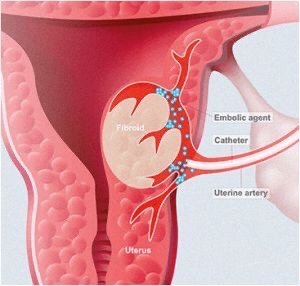Fibroids are noncancerous growths of the uterus that often appear during childbearing years. They are composed of muscle and fibrous tissue and can vary in size.
While they are usually not dangerous, they can cause discomfort and, in some cases, lead to complications.
Treatment options range from medication to surgical procedures, depending on the severity of symptoms and individual circumstances.
Doctors to see in case of Fibroids: Gynecologists, specifically those with expertise in reproductive health, are often the specialists who deal with fibroids. They can provide a thorough evaluation, discuss treatment options, and help you decide on the best course of action based on your individual circumstances.
There are three main types of fibroids, classified based on their location within the uterus:
Intramural Fibroids: These are the most common type and grow within the muscular walls of the uterus.
Subserosal Fibroids: These grow on the outside of the uterus, potentially causing pressure on nearby organs.
Submucosal Fibroids: These develop just under the lining of the uterine cavity and can protrude into the uterine cavity, potentially leading to heavy menstrual bleeding and other symptoms.
It’s also worth noting that some fibroids may be a combination of these types, and their size can vary widely.
Fibroids can grow in different locations within the uterus.
The main types include:
Intramural Fibroids: These are located within the muscular wall of the uterus.
Subserosal Fibroids: These grow on the outer surface of the uterus.
Submucosal Fibroids: These develop just beneath the inner lining of the uterus and may protrude into the uterine cavity.
Additionally, fibroids can also be pedunculated, meaning they have a stalk-like structure that attaches them to the uterine wall or the uterine cavity.
Causes:
The exact cause of fibroids is not entirely understood, but several factors may contribute to their development:
Hormones: Estrogen and progesterone, two hormones that stimulate the development of the uterine lining during each menstrual cycle, may promote the growth of fibroids. This is supported by the fact that fibroids tend to grow during the reproductive years when hormone levels are higher.
Genetics: There appears to be a genetic component to fibroids. If your mother or sister has had fibroids, you may be more likely to develop them.
Racial and Ethnic Factors: Fibroids are more common in certain racial and ethnic groups, particularly among Black women. They tend to develop at a younger age and may grow larger and cause more severe symptoms.
Uterine Blood Flow and Tissue Growth: An increased blood supply to the uterus and the presence of certain proteins that help with tissue growth may contribute to the development of fibroids.
Pregnancy and Hormonal Changes: Pregnancy and the associated hormonal changes may cause fibroids to grow. They often shrink after menopause when hormone levels decrease.
Environmental Factors: While not entirely proven, some environmental factors like exposure to certain chemicals or toxins may play a role in fibroid development.
Home Management:
Diet and Nutrition: Maintaining a balanced diet rich in fruits, vegetables, and whole grains may help. Some research suggests that certain foods like green leafy vegetables, fruits, and dairy products may be associated with a lower risk of developing fibroids.
Exercise: Regular physical activity can help manage weight and reduce the risk of developing fibroids. It may also help alleviate some symptoms.
Pain Management: Over-the-counter pain relievers like ibuprofen can provide relief for mild to moderate pain associated with fibroids.
Stress Reduction: Engage in activities that help reduce stress, like meditation, deep breathing exercises, yoga, or mindfulness practices.
Heat Therapy: Applying a heating pad or hot water bottle to the lower abdomen may help relieve pain and discomfort.
Avoid Heavy Lifting: Try to avoid heavy lifting or activities that strain the abdominal muscles.
Hydration: Stay well-hydrated by drinking plenty of water.
Monitor Symptoms: Keep track of your symptoms, their severity, and any changes.
In Conclusion:
Fibroids are noncancerous growths of the uterus that often appear during childbearing years. They are quite common, and while they can cause discomfort and other symptoms, they are usually benign.
Treatment options vary based on the severity of symptoms and a person’s individual circumstances.
It’s important to consult with a healthcare provider for a personalized assessment and to discuss appropriate treatment options if necessary.




